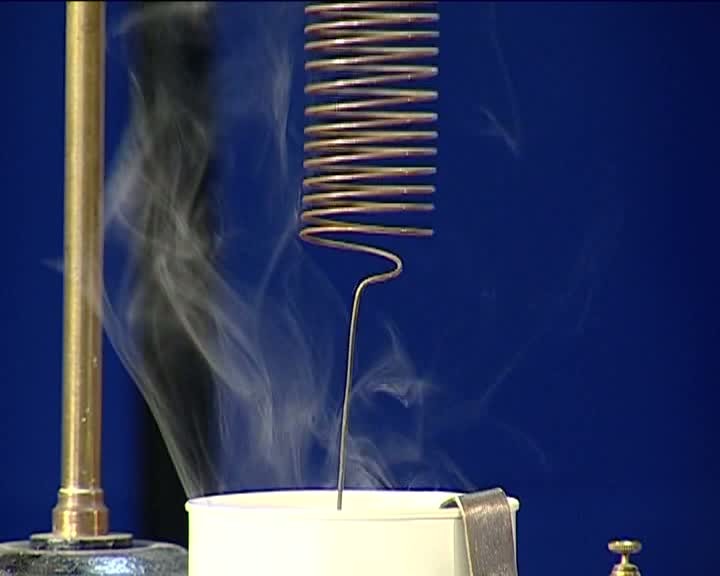„Párhuzamos áramvezetők közötti erőhatás” változatai közötti eltérés
| (egy szerkesztő 3 közbeeső változata nincs mutatva) | |||
| 15. sor: | 15. sor: | ||
Egy gyenge, saját súlyától is jelentősen megnyúló rugó menetein egyirányú párhuzamos áram folyik. Az adott összeállításban a rugóvég higanyba merülve zárja az áramkört. Ekkor a rugó menetei között vonzóerő lép fel, aminek hatására a rugó megrövidül és - kellően nagy áramerősségnél - kilépve a higanyból megszakad az áramkör. Áram nélkül az összehúzódott rugó megnyúlik, ismét záródik az áramkör és a folyamat kezdődik elölről. A gyors ismétlődés vezet a látható oszcillációhoz. | Egy gyenge, saját súlyától is jelentősen megnyúló rugó menetein egyirányú párhuzamos áram folyik. Az adott összeállításban a rugóvég higanyba merülve zárja az áramkört. Ekkor a rugó menetei között vonzóerő lép fel, aminek hatására a rugó megrövidül és - kellően nagy áramerősségnél - kilépve a higanyból megszakad az áramkör. Áram nélkül az összehúzódott rugó megnyúlik, ismét záródik az áramkör és a folyamat kezdődik elölről. A gyors ismétlődés vezet a látható oszcillációhoz. | ||
| − | == | + | == Force effect between parallel conductors == |
| − | Let us | + | Let us switch on a current in a weak spring that can be significantly stretched, even by its own weight, so that in the threads of the spring the current is parallel. In the given arrangement, the end of the spring is immersed in mercury, closing the circuit. Then, due to the attractive force between the threads of the spring, the spring will shorten, and – with strong enough current – it will withdraw from the mercury and the circuit will be broken. In the absence of current the spring will stretch again, close the circuit, and the process will start again. The repetition of the process will lead to visible oscillation. |
</wikitex> | </wikitex> | ||
A lap jelenlegi, 2013. július 1., 12:38-kori változata
A mágneses tér erővonalai zárt görbék, azaz a görbéknek nincs sem kezdetük (forrásuk), sem végük (elnyelődésük). Szemben az elektromossággal nincsenek mágneses monopólusok vagy magnetikusan töltött részecskék. Az áram hatására folyamatosan rezgő rugó egy "gravíto-elektromágneses" automata, amelyben az összehúzást az áramok mágneses kölcsönhatása intézi, a nyújtásról a súly, tehát a gravitációs erő intézkedik. Szükség van még az alkalmas eszközre, egy megfelelő vezetőképességű és alkalmas rugalmas tulajdonságokkal rendelkező, geometriailag jól megformált rugóra.
Működne-e rugó automatánk higany helyett fémlemezzel?
Hogyan lehetne a súlytalanság állapotában az áramtól átjárt rugóból hasonló automatát készíteni?
Az elhangzó szöveg
Egy gyenge, saját súlyától is jelentősen megnyúló rugó menetein egyirányú párhuzamos áram folyik. Az adott összeállításban a rugóvég higanyba merülve zárja az áramkört. Ekkor a rugó menetei között vonzóerő lép fel, aminek hatására a rugó megrövidül és - kellően nagy áramerősségnél - kilépve a higanyból megszakad az áramkör. Áram nélkül az összehúzódott rugó megnyúlik, ismét záródik az áramkör és a folyamat kezdődik elölről. A gyors ismétlődés vezet a látható oszcillációhoz.
Force effect between parallel conductors
Let us switch on a current in a weak spring that can be significantly stretched, even by its own weight, so that in the threads of the spring the current is parallel. In the given arrangement, the end of the spring is immersed in mercury, closing the circuit. Then, due to the attractive force between the threads of the spring, the spring will shorten, and – with strong enough current – it will withdraw from the mercury and the circuit will be broken. In the absence of current the spring will stretch again, close the circuit, and the process will start again. The repetition of the process will lead to visible oscillation.
